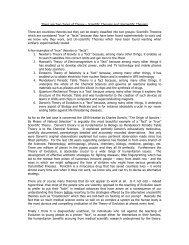Arise - Cliodynamics
Arise - Cliodynamics
Arise - Cliodynamics
You also want an ePaper? Increase the reach of your titles
YUMPU automatically turns print PDFs into web optimized ePapers that Google loves.
NATURE|Vol 454|3 July 2008<br />
OPINION<br />
France, the Thirty Years War in Germany, and<br />
the English Civil War and Glorious Revolution.<br />
Similarly, population growth during the<br />
eighteenth century was followed by the ‘age of<br />
revolutions’, ranging from the French Revolution<br />
of 1789 to the pan-European revolutions<br />
of 1848–49 (ref. 5).<br />
Such oscillations between population<br />
growth and instability have been termed<br />
‘secular cycles’ 6 . Given the limitations of historical<br />
data, we need an appropriately coarsegrained<br />
method to determine the statistical<br />
significance, and the generality, of the pattern.<br />
The basic idea is to demarcate population<br />
growth and decline phases,<br />
and to count the instability<br />
incidents (such as peasant<br />
uprisings and civil wars) that<br />
occur during each phase.<br />
With my colleagues<br />
Sergey Nefedov and Andrey<br />
Korotayev, I have collected<br />
quantitative data on demographic,<br />
social and political variables for<br />
several historical societies. Applying the<br />
above approach to eight secular cycles in<br />
medieval and early modern England, France,<br />
the Roman Empire and Russia, we find that<br />
the number of instability events per decade<br />
is always several times higher when the<br />
population was declining than when it was<br />
increasing 6 . The probability of this happening<br />
by chance is vanishingly small. The same<br />
pattern holds for the eight dynasties that<br />
unified China, from the Western Han to the<br />
Qing 7 , and for Egypt from the Hellenistic to<br />
the Ottoman periods 8 .<br />
Making waves<br />
Such strong regularity points to the presence<br />
of some fundamental principles. Population<br />
growth beyond the means of subsistence leads<br />
to declining levels of consumption and popular<br />
discontent, but this is not enough to destabilize<br />
agrarian societies. Peasant uprisings have little<br />
chance of success when the governing élites are<br />
unified and the state is strong 9 .<br />
The connection between population<br />
dynamics and instability is indirect, mediated<br />
by the long-term effects of population<br />
growth on social structures. One effect is the<br />
increasing number of aspirants for élite positions,<br />
resulting in rivalry and factionalism.<br />
Another consequence is persistent inflation,<br />
which causes a decline in real revenues and a<br />
developing fiscal crisis of the state. As these<br />
trends intensify, they result in state bankruptcy<br />
and a loss of military control; conflict<br />
among élite factions; and a combination of<br />
élite-mobilized and popular uprisings, leading<br />
to the breakdown of central authority 3,9 .<br />
“Societies as different<br />
as medieval France, the<br />
Roman Empire and China<br />
under the Han dynasty<br />
share dynamics.”<br />
This explanation — the ‘demographic–<br />
structural’ theory — is a work-in-progress.<br />
Our tests with the eight case studies 6 support<br />
some of its predictions: for example,<br />
élite overproduction preceded the crisis in<br />
every case. The tests also identify areas where<br />
the theory needs to be modified. Perhaps we<br />
need an entirely new theory to explain the<br />
observed patterns and predict new ones, but<br />
that is the business of science. The important<br />
thing is that societies as different as medieval<br />
France, the Roman Empire and China<br />
under the Han dynasty share dynamics, when<br />
viewed in an appropriately coarse-grained<br />
way. Not everything in<br />
history is contingent and<br />
particular.<br />
Even so, theories developed<br />
and tested on preindustrial<br />
data must be<br />
modified before they can<br />
be applied to contemporary<br />
social dynamics. Happily,<br />
there are indications that our theories will not<br />
need to be replaced wholesale. Rapid demographic<br />
change and élite overproduction were<br />
still important factors in twentieth-century<br />
revolutions 10 .<br />
Furthermore, over the past 200 years,<br />
political instability in the United States has<br />
waxed and waned in a pattern reminiscent of<br />
that in pre industrial societies. Political violence<br />
— urban riots, lynchings, violent labour disputes<br />
and so on — was almost absent in the<br />
early nineteenth century, increased from the<br />
1830s and reached a peak in around 1900.<br />
The American Civil War occurred during this<br />
period of growing unrest. The instability then<br />
subsided during the 1930s, and the following<br />
two decades were remarkably calm. Finally, in<br />
the 1960s, political violence increased again 11 .<br />
It remains to be seen whether a modified<br />
version of the demographic–structural<br />
theory can explain this pattern. The point is<br />
that the study of such slow-moving processes<br />
requires a long-term view and an explicitly<br />
historical approach.<br />
Learning lessons<br />
Any claim that history can become a predictive<br />
science raises eyebrows. But scientific<br />
prediction is a broader concept than merely<br />
forecasting the future. It can be used to test<br />
theories. For example, two rival theories may<br />
make different predictions about the behaviour<br />
of some variable, such as birth rate,<br />
under certain social conditions. We then ask<br />
historians to explore the archives, or archaeologists<br />
to dig up data, and determine which<br />
theory’s predictions best fit the data. Such<br />
retrospective prediction, or ‘retrodiction’, is<br />
© 2008 Macmillan Publishers Limited. All rights reserved<br />
the life-blood of historical disciplines such as<br />
astrophysics and evolutionary biology.<br />
Cliodynamic theories will not be able to<br />
predict the future, even after they have passed<br />
empirical tests. Accurate forecasts are often<br />
impossible because of phenomena such as<br />
mathematical chaos, free will and the selfdefeating<br />
prophecy. But we should be able to<br />
use theories in other, perhaps more helpful,<br />
ways: to calculate the consequences of our<br />
social choices, to encourage the development<br />
of social systems in desired directions, and to<br />
avoid unintended consequences.<br />
Like other systems with nonlinear feedback,<br />
societies often respond to interventions<br />
in surprising ways. When the Assembly of<br />
Notables refused to approve a new land tax in<br />
1787, they did not intend to start the French<br />
Revolution, in which many of them lost their<br />
heads. When Tony Blair was Britain’s prime<br />
minister, he set out to increase the proportion<br />
of youth getting higher education to 50%. He<br />
was presumably unaware that the overabundance<br />
of young people with advanced education<br />
preceded the political crises of the age<br />
of revolutions in Western Europe 12 , in late<br />
Tokugawa Japan and in modern Iran and the<br />
Soviet Union 9,10 .<br />
It is time we heeded the old adage that those<br />
who do not learn from history are doomed to<br />
repeat it. We must collect quantitative data,<br />
construct general explanations and test them<br />
empirically on all the data, rather than on<br />
instances carefully selected to prove our pet<br />
narratives. To truly learn from history, we<br />
must transform it into a science.<br />
■<br />
Peter Turchin is professor of ecology and<br />
mathematics at the University of Connecticut,<br />
Storrs, Connecticut 06269, USA. He is the author<br />
of War and Peace and War: The Life-Cycles of<br />
Imperial Nations (Pi Press, 2006).<br />
1. Demandt, A. Der Fall Roms: die Auflösung des Römischen<br />
Reiches im Urteil der Nachwelt (Beck, Munich, 1984).<br />
2. Turchin, P. Historical Dynamics: Why States Rise and Fall<br />
(Princeton Univ. Press, 2003).<br />
3. Turchin, P. War and Peace and War: The Life Cycles of<br />
Imperial Nations (Pi Press, 2006).<br />
4. Mack, A. (ed.) Human Security Report 2005: War and Peace<br />
in the 21st Century (Oxford Univ. Press, 2005).<br />
5. Fischer, D. H. The Great Wave: Price Revolutions and the<br />
Rhythm of History (Oxford Univ. Press, 1996).<br />
6. Turchin, P. & Nefedov, S. Secular Cycles (Princeton Univ.<br />
Press, 2008).<br />
7. Nefedov, S. PhD dissertation [in Russian] (Ekaterinburg<br />
Univ., 1999).<br />
8. Korotayev, A. & Khaltourina, D. Introduction to Social<br />
Macrodynamics: Secular Cycles and Millennial Trends in Africa<br />
(URSS, 2006).<br />
9. Goldstone, J. A. Revolution and Rebellion in the Early Modern<br />
World (Univ. California Press, 1991).<br />
10. Goldstone, J. A. J. Int. Affairs 56, 3–21 (2002).<br />
11. Levy, S. G. Political Violence in the United States, 1819-1968.<br />
(Computer file, Inter-University Consortium for Political<br />
and Social Research, Ann Arbor, 1991).<br />
12. O’Boyle, L. J. Modern Hist. 42, 471–495 (1970).<br />
35






